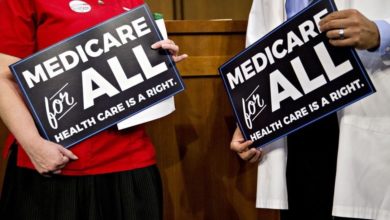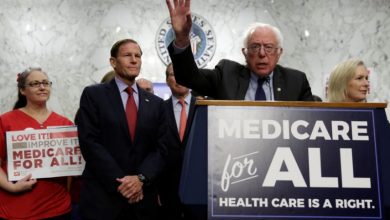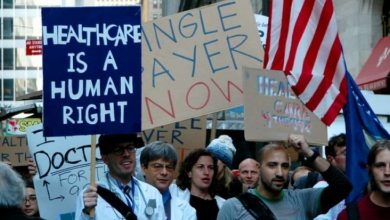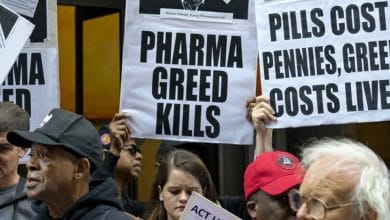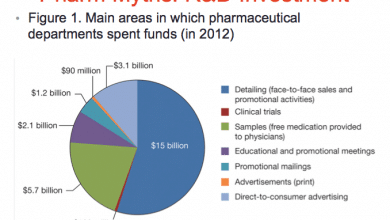HealthcareTaxes
While we weren’t looking, Big Pharma spent millions of our tax dollars on themselves
Big Pharma claimed that they’d use a massive tax break to pay for research and new jobs. Instead, they took our money and ran.

[dropcap]F[/dropcap]or a wildly profitable industry with a bloodstained grip on our politics and economy, Big Pharma sure does whine a lot.
Drug makers enjoy fatter profit margins than any other sector — rivaled only by banking, also its closest competitor for the crown of biggest criminal fines. Yet Big Pharma and its buy-a-vowel trade group, PhRMA, have perfected a tone of aggrieved victim; as if they, and not the taxpayers who fund most of the research underlying their products, are the ones forced to choose among rent, food, and murderously overpriced drugs.
If you’ve ever read about the running scandal of drug prices, you’ll recognize some of Big Pharma’s favorite lines:
R&D is so expensive! Our products save lives! We’re unfairly targeted because people just don’t understand the complexities of patents and the drug pipeline! We’re competing with foreign companies with lower corporate taxes!
As defenses of Big Pharma, not one of these holds up under scrutiny. The real reason drugs cost so much in the U.S. is simple: our system is designed for the benefit of publicly traded drug companies, whose trade group last year spent nearly $26 million lobbying to defend this system and tweak its design even further to its advantage.
This can be seen clearly in Big Pharma’s role in, and response to, the 2017 tax bill. The bill handed the biggest drug companies a sweetheart deal not just on the taxes they’ll have to pay in the future, but also on an estimated $175 billion in cash the industry has been stowing away overseas to avoid paying taxes on it in the first place. Taxes like the ones, it cannot be said enough, that pay for the basic research that the industry then leverages for so many of its patented drugs — drugs like Sovaldi, a treatment for hepatitis C with a near-perfect cure rate. Sovaldi was developed with taxpayer dollars by a researcher who worked for the Department of Veterans Affairs, but his small company was swooped up by pharma giant Gilead in 2012. Gilead turned around and priced the treatment at $84,000 a pop. Today, the VA buys its Sovaldi from Gilead for $42,000 per patient, spending over 1 billion dollars in the last year alone for a drug it paid to invent.
Big Pharma was at the forefront of Corporate America’s lobbying efforts to pass the 2017 bill. Pfizer CEO Ian Read even boasted about it on an investor call last month, saying, “I do believe that Pfizer was to play a major role in putting a spotlight on the disadvantageous corporate tax situation for U.S. multinationals.”
Read and his fellow execs knew their industry would be among the biggest winners of a change in the “tax situation” that let U.S. companies offshore hundreds of billions in profit for decades. The bill Trump signed on December 22 was indeed an advantageous change for Big Pharma, largely exempting them from taxes on future foreign profits, and allowing them to repatriate money parked overseas — that is, to bring it back to the US where it could be taxed — with low, one-time rates of between 8 and 15.5 percent, a figure much too low to get back what Big Pharma actually owes us.
What did our “life-saving” Big Pharma, so heroic in its own eyes, do with all this money? Did they transfer it into new labs and research projects? Hire more scientists and technicians? Fund science scholarships and education? Subsidize drugs currently priced beyond the reach of millions of poor people around the world?
You have one more guess.
The industry did exactly what it did last time it won a tax crusade: it paid itself handsomely and drove up the price of its biggest stocks.
“A lot of money will go back to shareholders in the form of dividends and buybacks,” reported Bloomberg Businessweek’s Max Nielson, after listening to industry executives at last month’s J.P. Morgan Healthcare Conference in San Francisco. “Research and development spending will be about the same.”
Dividends and buybacks are, in essence, bonuses you get for doing nothing. “Dividends” are payments made to shareholders (read: not researchers), either in the form of cash or stocks; a “buyback” is the act of a company buying back its own stock. They were illegal for most of the 20th century, because they were viewed as a kind of market manipulation: when a company buys a ton of stock, the stock price goes up, and the company gets to turn around and profit on the difference. Massachusetts Senator Elizabeth Warren once called them, aptly, a “sugar high” for big corporations, boosting its stock prices — and its profit per share — in the short term while doing nothing to build its value in the long term (as opposed to, say, research and development).
The Indianapolis Star, the hometown paper of HHS Secretary Alex Azar’s old company, Eli Lilly, reported the company’s intention to spend its lightly taxed billions on stock buybacks that enrich executives and shareholders. It’s a similar story with Abbvie, the maker of the auto-immune disease drug Humira, the world’s best-selling drug. Pfizer, the Big of Big Pharma, has issued a flurry of press releases about all the good it plans to do with its tax windfall — $200 million for the Pfizer Foundation, $500 million for its pension plan, some one-time bonuses of $1,000 — but not one about its biggest response to the tax bill: authorizing $10 billion in share buybacks, 50 times the amount it’s giving to its so-called charity.
This isn’t the first time we’ve seen this script. When Pharma started lobbying for the 2017 tax law, often citing all the new jobs they would create, industry observers experienced an unpleasant déjà vu. “New jobs” was exactly what the industry promised — much more loudly — in the run-up to the 2004 tax bill. But after George W. Bush signed the law allowing drug makers to haul back billions at the low, low rate of 5.25 percent, they proceeded to shutter labs, abandon research projects, order mass layoffs, and spend the money on stock buybacks. As Damian Garde of the medical site STAT news wrote in a review summary of that brazen Bush-era bait-and-switch:
Drug makers used the tens of billions they brought back to the US to enrich their CEOs and drive up their stock prices. Rather than adding jobs, they laid off thousands of workers.
Pfizer repatriated $35.5 billion [and] cut nearly 12,000 jobs [while] payouts to its executives increased by $13 billion. Johnson & Johnson moved $10.7 billion into the US, and then shed more than 4,000 employees while hiking executive pay by $32 billion. Merck repatriated $15.9 billion, laid off 1,000 workers, and boosted executive pay by more than $20 billion… Stock prices soared.
If this sounds a lot like big bank behavior, that’s because big banks and Big Pharma live pretty close to one another on Wall Street. It’s certainly possible, if unlikely, that there are pharma industry executives who might have preferred not to “shred” their companies to please those big bank counterparts. But the connection between the two industries means that even a CEO with a conscience can’t stand up to the intense pressure from big banks looking for big returns for investors.
A damning investigation by Jonathan Larson of TYT, published two days before Trump signed the tax bill on December 22, exposed just how intense that pressure can be. Larson obtained transcripts of Goldman Sachs healthcare analyst Jodi Rubin browbeating Eli Lilly CEO David Ricks into promising to fire people and cut costs in order to increase their profit margins, even and especially with the expected truckloads of tax cut money on the way.
It’s a good bet that at least some of the industry’s tax windfall will also go toward building up their trade group, PhRMA. PhRMA is experiencing a sudden growth spurt, calling for an extra $10 million in annual fees to pay for its PR blitz — a blitz spurred on partly by growing industry anxiety over mounting public outrage and a plummeting reputation.
The industry would have us believe that outrage results from public misunderstanding and a lack of an effective communications strategy. But in 2018, people are beginning to understand the industry with crystal clarity. Despite the power of its current position, PhRMA is right to be worried.
This piece is part of the Drug Prices are Too High series, sponsored by Social Security Works. If you want to take on Big Pharma and lower drug prices, sign our petition here.

